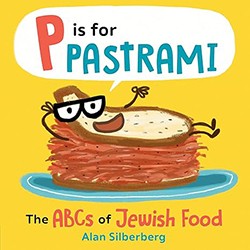Alan Silberberg has amused and educated young readers with Meet the Latkes and Meet the Matzah. But if there is one Jewish food that seems the funniest that might be the funniest, it’s the three-cornered pastry associated with Purim. In Meet the Hamantaschen, Silberberg finds a new premise for introducing the holiday of both Jewish self-preservation and outrageously zany celebrations. This time, the traditional treat is the object of a detective story, including all the off-beat humor and deep love for Yiddishkeit that have made Silberberg’s series a success.
Right away, the unusual angle of this Purim-themed story captures the reader’s attention. Mysteries involve the application of reason, and Purim is all about turning reason on its head. In spite of this paradox, be assured that Silberberg’s signature silliness is still at the forefront. His hamantaschen detectives are tasked with a great responsibility: finding the missing megillah, without which the holiday’s narrative cannot be heard. Three hardboiled, or rather baked, crime-solvers are on the scene, straight out of a 1930s mystery movie. When a mysterious stranger meets them under a streetlight, presenting a fact file crucial to their task, they don’t flinch.
Not a page goes by without clever rhymes, funny puns, or personality-revealing statements, such as the gefilte fish who nostalgically states, “I miss Tu B’Shvat.” There is a method to Silberberg’s madness; all of these attention-grabbing gimmicks teach children about Purim. Deliberate anachronisms add to the story’s attraction. Queen Vashti could not actually have planted a computer chip in King Ahasuerus’s brain, but it would have been the perfect revenge for a husband who sought to control everyone around him. While the events of Purim definitely predate baseball, America’s favorite pastime would have been perfect at the court of a monarch who loved to be entertained. The juxtaposition of different times and places sets Silberberg’s works, including this latest, apart from other holiday books. As every reader of fairy tales knows, the past speaks to the present.
Hamantaschen are not the only foods to participate in solving the mystery; blintzes, matzah balls, and kreplach also play crucial roles. Instead of compartmentalizing each Jewish holiday, Silberberg prefers to invite many different cultural markers into the mix. Each one takes the opportunity to indulge in hilarious shtick but also to correct misconceptions and present accurate facts: “… Queen Esther was Jewish and felt forced to hide who she truly was.”
Every dish depicted is uniquely personified. Melvin the matzah ball, as the king, sports round glasses and a scruffy beard. Barry the kreplach has an appropriately devilish mustache and goatee, and the heroine Esther is a lovely, crowned rugelach. Characters’ exaggerated features, as well as word bubbles filled with upper-case letters and exclamation marks, appeal to the artistic sensibilities of children. By the end of the book, readers will certainly agree with the refrain repeated by the hamantaschens’ friend, Cookbook: “We know what we knew … But now what we know is THE NEWEST.”
Meet the Hamantaschen is highly recommended and includes a Purim glossary.
Emily Schneider writes about literature, feminism, and culture for Tablet, The Forward, The Horn Book, and other publications, and writes about children’s books on her blog. She has a Ph.D. in Romance Languages and Literatures.





